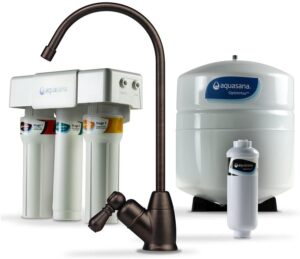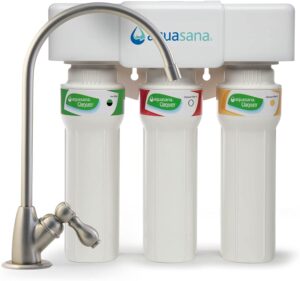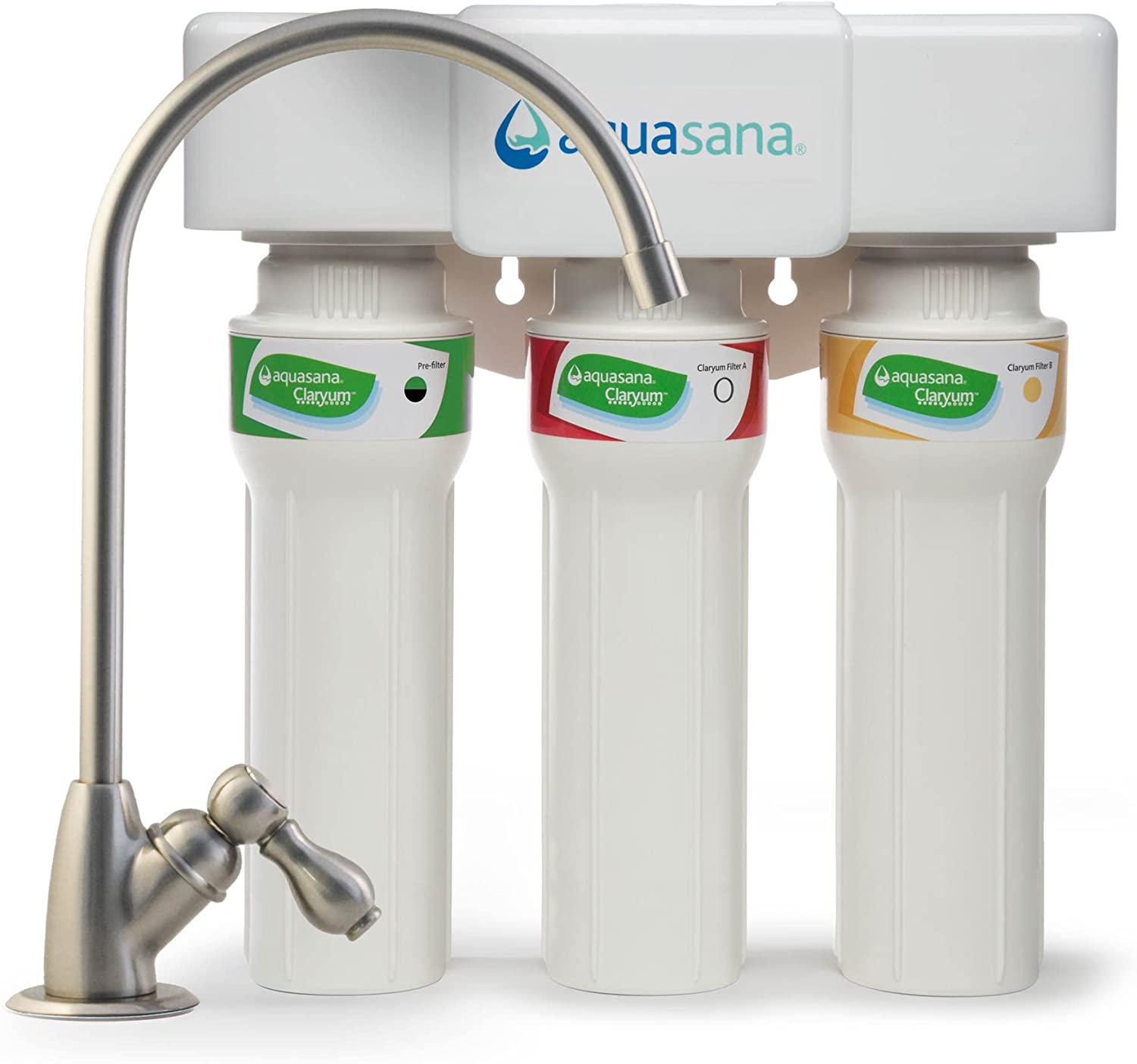Reverse osmosis and carbon filters are both good options for water purification, but if you are not sure which one is best for your needs. We’re here to help you regarding aquasana water filter vs reverse osmosis.
Every water filter on the market has its own set of advantages and disadvantages that set it apart from the rest. As much information as possible about different types of water filters is our goal so that you can make an educated decision about which is best for your home. We aim to provide you with the best when it comes to aquasana water filter vs reverse osmosis.
Table of Contents
Comparison Table for Aquasana water filter vs reverse osmosis
Reverse Osmosis: Hoe does it work?
A semipermeable membrane is used in reverse osmosis (RO) to retain solid contaminants while allowing clean water to pass through to the other side. Objects that are too large to fit through the opening are kept out of the water. So this method is great for eliminating anything larger than the water molecule, including common pollutants like lead, asbestos, chlorine, and a range of other chemicals.
Using Reverse Osmosis Water Filters
PROS
With its ability to remove impurities as small as 0.1 microns, reverse osmosis is especially popular among chefs since it provides the best water for cooking and removes more contaminants than any other filtration system.
CONS
RO systems produce a large volume of wastewater during the process; the wastewater-to-water ratio is typically 4:1. In other words, for every gallon of potable water produced, four gallons of waste are generated in the process. Using electricity to force water through the RO membrane or recycle wastewater increases wear and tear on your RO system, which necessitates more regular filter replacements.
Because RO systems are so good at removing particles, they have the unpleasant side effect of removing important minerals like calcium, potassium, and magnesium from the water supply. Aquasana OptimH2O Reverse Osmosis + Claryum Filter employs remineralization technology to retain these critical minerals while also restoring water to a normal pH balance, which addresses this issue.
In what way do Carbon Filters function?
In this section of Aquasana water filter vs reverse osmosis, we shall discuss the working of carbon filters. The carbon filtering technique is used by the majority of water filters on the market today, preventing contaminants from flowing through your faucet or showerhead. Since molecules exert force on one other and are attracted to other molecules by the filter’s surface area due to adsorption, carbon filters work like magnets. Toxins are more readily absorbed from water that has been in contact with carbon medium for an extended period.
Carbon filters come in two main varieties:
- Activated carbon
- Pre-activated carbon.
Coal or wood-activated carbon media is utilised in most water filters because it is more effective than any other type of activated carbon media available. Thus, these filters are extremely porous; one teaspoon has more surface area than an entire football field, allowing them to effectively remove impurities by adsorption. As a result
When it comes to removing chlorine and chloramines from water, catalytic carbon is an excellent choice because of its capacity to promote chemical reactions as well as its many other advantages over normal activated carbon. Chlorine and chloramines can be removed from tap water using catalytic carbon.
Using Carbon filters
When combined with a carbon filter, it is especially effective in removing chlorine, resulting in better-tasting water that is also safer to drink. Additionally, because they are passive filters, no water or electricity is wasted as the water passes through, allowing you to save money. In addition to the fact that they require little to no maintenance, save for an occasional filter change every few months, they are highly appealing to consumers.
Comparison of Aquasana water filter vs reverse osmosis
Reverse osmosis and carbon filters both have advantages and downsides to weigh when making a water filter purchase for your home. Carbon filters are good at eliminating chlorine from water. However, depending on where you live, a single-stage carbon filter will not be able to remove all of the toxins from your tap water. As a general rule, reverse osmosis filters have a much higher capacity for removing contaminants than other water purification systems, but they also remove beneficial minerals from the water.
You may remove up to eighty-eight pollutants from your water by using the Aquasana OptimH2O® Reverse Osmosis + Claryum® Filter with activated and catalytic carbon filters, together with ion exchange, to purify your water. Now you would have an understanding of the Aquasana water filter vs reverse osmosis.
OptimH2O Reverse Osmosis System

Aquasana’s OptimH20 reverse osmosis system is the best option for those seeking the most thorough pollution removal. One of the most effective water filtration systems we’ve encountered is Aquasana’s version of RO, which eliminates nearly all TDS from the water.
Features of OptimH2O Reverse Osmosis System
It comes with the following Aquasana RO filter components and is intended for placement beneath the sink. Moreover, the Aquasana reverse osmosis system comes with a free initial set of filters.
- Package components
Filters and membranes for reverse osmosis are packaged in their containers.
- Faucets with no lead
The integrated faucet comes in your choice of brushed nickel, chrome, or oil-rubbed bronze. All of the designs are completely free of lead.
- Tubing and fittings
The Aquasana OptimH20 comes with all of the fittings and tubing you’ll need for installation.
Functionality
The procedures used to remove contaminants from water set the OptimH20 apart from conventional reverse osmosis systems. It uses a RO membrane to remove contaminants like nitrates, lead, arsenic, and fluoride from water, much like any other RO system. The Claryum® filter removes an additional 74 pollutants as the water passes through it.
The effectiveness of RO systems is such that even essential elements like calcium and magnesium are removed from the water. Reintroducing these minerals to water is a feature of OptimH20’s remineralization filter.
The RO membrane lasts a year; the remineralized lasts a year, and the Claryum® filter lasts six months in this water filtering system.
3-Stage Max Flow Under Counter Water Filter

This Aquasana water filter for under-sink installation is a wonderful choice if you’re seeking precise water filtration for your kitchen faucet. An NSF-certified filter, it is one of Aquasana’s most effective and efficient filters.
Features of 3-Stage Max Flow Under Counter Water Filter
Aquasana Max Flow under-counter water filter system comes with the following features and benefits:
- Three-piece filter set
The first three filters are already included in the system and need to be put into the filter housing before use.
- The filter housing
Dust and air particles are kept out of the system’s filters by using this method.
- Faucet
Brushed nickel, chrome, and oil-rubbed bronze are the available finishes for your faucet. All of the faucets are lead-free and will not contaminate your water in any way.
- Tubing and fittings
Several brass fittings and tubing should be used to connect the under-sink system directly to your water supply. Connecting tubing and fittings to the faucet are also necessary.
Functionality
Claryum activated carbon and catalytic carbon media, is used in Aquasana’s under-sink water filtration system. During the filtering process, pollutants are removed from the water and trapped in the filter’s media. An ion exchange medium, which removes heavy metals and mercury, and an absolute sub-micron mechanical filtration media, which removes cysts and asbestos from the water.
About six months of use should be expected from a filter before it has to be replaced. The good news is that the system will alert you when it’s time for a filter replacement so you don’t miss out on any opportunities.
Editor’s Choice
Aquasana’s OptimH20 reverse osmosis system becomes the winner of this aquasana water filter as it is among the best in terms of removing a wide range of pollutants, including potentially harmful microorganisms. Moreover, the reverse osmosis membrane is pushed through by applying pressure to the filters.
Conclusion
Chelating agents like chlorine taste and odor are effectively removed by carbon filtering. Moreover, it performs admirably in terms of trapping big particles. On the other hand, reverse osmosis can remove nearly everything from your water, but it performs better if the large particles are removed first to avoid premature fouling of the membrane.
I hope that this information about Aquasana water filter vs reverse osmosis will be helpful for you.

